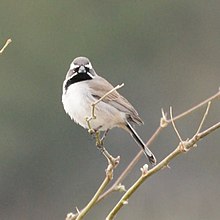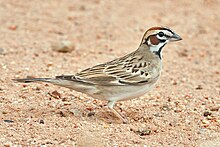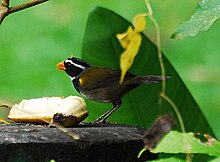New World Chambers
| New World Chambers | ||||||||||||
|---|---|---|---|---|---|---|---|---|---|---|---|---|

Fox bunting ( Passerella iliaca ) |
||||||||||||
| Systematics | ||||||||||||
|
||||||||||||
| Scientific name | ||||||||||||
| Passerellidae | ||||||||||||
| Cabanis & Heine , 1850 |
The New World chambers (Passerellidae) are a family from the order passerine birds . They belonged to the Ammern family (Emberizidae) for a long time , but are currently regarded as an independent family due to phylogenetic differences. The family comprises 30 genera with 145 species that are distributed in North, Central and South America as well as in the Caribbean.
features
The New World chambers belong to the songbirds with nine visible hand swing feathers . The plumage is dominated by brown, white, olive, black and yellow parts. The body length varies from north to south. While the smaller species occur in North America, the largest species are common in Central and South America. The plumage also differs in the northern and southern areas of distribution. In the north the birds are more brownish, dashed and have head patterns. In southern latitudes, where they inhabit the thick undergrowth, they are less dashed. They contrast larger olive, reddish brown, black and gray areas. Some species are broadly patterned, but most are quite dark. The medium-length wings are rounded. The tail is short to medium in length. The body is small to medium in length, cylindrically ovoid and compact. The conical beak is usually short. The head is medium to large in size. The neck is thick to medium in length. The legs are of medium length. The feet are medium to long. The sexes generally look the same.
habitat
New World chambers inhabit a wide variety of habitats, including peat bogs, the tundra, tropical lowland and mountain rainforests, wetlands, grasslands, bushland and savannas.
Eating behavior
The New World chambers in the temperate zones feed on a variety of invertebrates, fruits and seeds. The latter dominates food intake, especially outside the breeding season. The proportions of vegetable and animal diets vary from species to species. Little data is available on the food preferences of tropical species, but they are unlikely to differ from species from temperate zones.
Reproductive behavior
The New World chambers are generally monogamous. In the case of some species from wetlands, however, frequent partner changes can also occur. Both parents take care of raising the young. The open, bowl-shaped nest is built from grass, twigs and other materials. The nests are placed in trees, bushes or on the ground. Some species, including the pine bunting ( Peucaea aestivalis ) and the taxa of the genus Arremon , build dome-shaped nests. The females usually lay one to seven eggs. In most New World chambers, the female alone takes care of building the nest and incubating the eggs. Both parents take care of the procurement of food and the defense of the nest against predators or rivals. The breeding season is 12 to 15 days and the nestling period about seven to 15 days. After the young have fledged, they stay with their parents for about a month.
Systematics










In 1850, Jean Louis Cabanis and Ferdinand Heine introduced the subfamily Passerellinae. It was considered part of the finch family (Fringillidae) and was given the common name of Ammerfinken. To the subfamily Passerellinae the genera belonged Passerculus , Passerella (with the eponymous type species Passerella iliaca Swainson 1837), Zonotrichia , Ammodramus , Peucaea , Haemophila (current Synonym: Aimophila ) Coturniculus (current Synonym: Ammodramus ) Euspina (current Synonym: Spiza from the Family of the cardinals ), Spinites (current synonym: Spizella ), Niphaea (current synonym: Junco ), Phrygilus (currently belongs to the family of the Tangaren ), Rhopospina (currently belongs to the family of the Tangaren) and Hedyglossa (current synonym Diuca from the family of the Tangerines). In the same publication, some genera that are currently assigned to the family Passerellidae have been incorporated into the subfamily Pitylinae (oar finches). These include the genera Chlorospingus , Pipilo , Atlapetes , Arremon and Buarremon (currently a synonym for Arremon ).
Traditionally, the New World chambers were considered part of the Emberizidae family (currently Old World chambers) sensu lato . Several phylogenetic studies, however, came to the conclusion that the two groups form different clades , with the families of the wood warbler (Parulidae) and the starling (Icteridae) as well as smaller families endemic to the Caribbean being considered as the closest relatives of the New World chambers. The New World Chambers are divided into eight clades: Clade I comprises the genus Melospiza , clades II to III the genera Melozone , Atlapetes and Pipilo and clades IV to VIII the genera Zonotrichia and Junco . All other species that branch out at the root of the family tree, that is, form a polytomy, belong to the genera Arremon , Spizella , Amphispiza , Chondestes , Calamospiza , Peucaea , Arremonops , Ammodramus and Rhynchospiza . The two genera Oreothraupis and Chlorospingus , which originally belonged to the Tangaren , are currently also among the New World chambers.
The ornithological checklist committees are increasingly accepting the New World Chambers as an independent family, including Dickinson & Christides (The Howard and Moore Complete Checklist of the Birds of the World, Vol. 4, Passerines, 2014), Winkler et al. (Bird Families of the World, 2015), the Handbook of the Birds of the World (del Hoyo et al., Including Birdlife International and the IUCN, 2016), the American Ornithological Society (formerly American Ornithologists' Union , 2017), the International Ornithological Congress (2017) and ebird / Clements (2017).
The Handbook of the Birds of the World (2017) distinguishes between the following genera and species:
-
Spizella (6 species)
- Schwirrammer ( Spizella passerina )
- Pale bunting ( Spizella pallida )
- Black-chin Chamber ( Spizella atrogularis )
- Rattle hammer ( Spizella pusilla )
- Blowhammer ( Spizella breweri )
- Mexican hammer ( Spizella wortheni )
-
Amphispiza (2 species)
- Black-throated sparrow ( Amphispiza bilineata )
- Five-striped bunting ( Amphispiza quinquestriata )
-
Chondestes (1 kind)
- Rainammer ( Chondestes grammicus )
-
Calamospiza (1 species)
- Prairie bunting ( Calamospiza melanocorys )
-
Rhynchospiza (2 species)
- Tumbesammer ( Rhynchospiza proudmanni )
- Striped Parrot ( Rhynchospiza strigiceps )
-
Peucaea (8 species)
- Cinnamon tails ( Peucaea sumichrasti )
- Rust-winged hammer ( Peucaea carpalis )
- Redtail bammer ( Peucaea ruficauda )
- Black-breasted bammer ( Peucaea humeralis )
- Rein bammer ( Peucaea mystacalis )
- Striped Back Bammer ( Peucaea botterii )
- Cassinammer ( Peucaea cassinii )
- Pine bunting ( Peucaea aestivalis )
-
Arremonops (4 species)
- Olive bammer ( Arremonops rufivirgatus )
- Green back bunting ( Arremonops chloronotus )
- Tocuyoammer ( Arremonops tocuyensis )
- Thicket bammer ( Arremonops conirostris )
-
Ammodramus (3 species)
- Grasshopper ( Ammodramus savannarum )
- Quail ( Ammodramus humeralis )
- Yellow-cheeked hammer ( Ammodramus aurifrons )
-
Oreothraupis (1 species)
- Tangarenbuschammer ( Oreothraupis arremonops )
-
Green bugs ( Chlorospingus ) (9 species)
- Finch bunting ( Chlorospingus flavopectus )
- Tacarcuna green bunting ( Chlorospingus tacarcunae )
- Black-cheeked bunting ( Chlorospingus inornatus )
- Gray-breasted green bunting ( Chlorospingus semifuscus )
- White-browed green bunting ( Chlorospingus pileatus )
- Short-billed green bunting ( Chlorospingus parvirostris )
- Orange-throated green bunting ( Chlorospingus hypophaeus )
- Yellow-throated green bunting ( Chlorospingus flavigularis )
- Gray-throated green bunting ( Chlorospingus canigularis )
-
Rowing chambers ( Arremon ) ( Buarremon is a synonym) (21 species)
- Thick-billed bushhammer ( Arremon crassirostris )
- Olive bushhammer ( Arremon castaneiceps )
- Brown -headed Bushhammer ( Arremon brunneinucha ) (The form Arremon kuehnerii , described in 2013, is regarded by HBW as a synonym of Arremon brunneinucha )
- Green vertex Buschammer ( Arremon virenticeps )
- Gray-banded bushhammer ( Arremon costaricensis )
- Narrow-beaked bushhammer ( Arremon assimilis )
- Breast spot bushhammer ( Arremon basilicus )
- Perijá bushhammer ( Arremon perijanus )
- Striped Bushhammer ( Arremon torquatus )
- Schwarzkopf bushhammer ( Arremon atricapillus )
- Caracas bush hammer ( Arremon phaeopleurus )
- Berlepschbuschammer ( Arremon phygas )
- Yellow-billed Bushhammer ( Arremon flavirostris )
- Half-ring bush hammer ( Arremon axillaris )
- Black ring bush hammer ( Arremon taciturnus )
- Collared Bushhammer ( Arremon semitorquatus )
- Franziskusbuschammer ( Arremon franciscanus )
- Hooded Bushhammer ( Arremon abeillei )
- Marañón bush hammer ( Arremon nigriceps )
- Golden beak bushhammer ( Arremon aurantiirostris )
- Goldwing Bushhammer ( Arremon schlegeli )
-
Basic bunting ( Pipilo ) ( Pipilio is a synonym) (5 extant species and a latter day extinct species)
- Collar root hammer ( Pipilo ocai )
- Green-tailed gullet ( Pipilo chlorurus )
- Spotted bunting ( Pipilo maculatus )
- Socorrogrundammer ( Pipilo socorroensis )
- Rötelgrundammer ( Pipilo erythrophthalmus )
- Bermuda hammer ( Pipilo naufragus ) †
-
Pselliophorus (2 species)
- Yellow- thigh Bushhammer ( Pselliophorus tibialis )
- Anthracite bush hammer ( Pselliophorus luteoviridis )
-
Bushhammer ( Atlapetes ) (33 species)
- Red cap bushhammer ( Atlapetes pileatus )
- Méridabuschammer ( Atlapetes meridae )
- Whitebeard Bushhammer ( Atlapetes albofrenatus )
- Ocher breast bush hammer ( Atlapetes semirufus )
- Tepuibo hammer ( Atlapetes personatus )
- White- naped bushhammer ( Atlapetes albinucha )
- Gray-eared Bushhammer ( Atlapetes melanocephalus )
- Cinnamon-browbush ( Atlapetes pallidinucha )
- Golden-headed bushhammer ( Atlapetes flaviceps )
- Rußkopf-Buschammer ( Atlapetes fuscoolivaceus )
- Golden shrub ( Atlapetes crassus )
- Tricolor bushhammer ( Atlapetes tricolor )
- African bushhammer ( Atlapetes leucopis )
- Black-fronted Bushhammer ( Atlapetes nigrifrons )
- Yellow-breasted Bushhammer ( Atlapetes latinuchus )
- Antioquia Bushhammer ( Atlapetes blancae )
- Red-eared bushhammer ( Atlapetes rufigenis )
- Forbes bushhammer ( Atlapetes forbesi )
- Black-eyed Bushhammer ( Atlapetes melanopsis )
- Gray breasted bushhammer ( Atlapetes schistaceus )
- Taczanowskibuschammer ( Atlapetes taczanowskii )
- Mirror Bushhammer ( Atlapetes leucopterus )
- White crowned bushhammer ( Atlapetes paynteri )
- Bald bushhammer ( Atlapetes albiceps )
- Blasskopf-Bushammer ( Atlapetes pallidiceps )
- Red-headed bushhammer ( Atlapetes seebohmi )
- Rust-bellied bushhammer ( Atlapetes nationi )
- Slate bush hammer ( Atlapetes canigenis )
- Vilcabambabuschammer ( Atlapetes terborghi )
- Black-faced bushhammer ( Atlapetes melanolaemus )
- Red-necked bushhammer ( Atlapetes rufinucha )
- Brown Beard Bushhammer ( Atlapetes fulviceps )
- Black Beard Bushhammer ( Atlapetes citrinellus )
-
Pezopetes (1 kind)
- Big-footed bush hammer ( Pezopetes capitalis )
-
Torreornis (1 kind)
- Zapataammer ( Torreornis inexpectata )
-
Melozone (9 species) ( Kieneria is a synonym )
- Rostnacken-Grundammer ( Melozone kieneri )
- Brown-backed hamster ( Melozone fusca )
- White-throated ground bammer ( Melozone albicollis )
- California ground bammer ( Melozone crissalis )
- Black-chin ground hammer ( Melozone aberti )
- Glasses basic bunting ( Melozone biarcuata )
- Red-eared ground hammer ( Melozone cabanisi )
- Yellow-naped basal bunting ( Melozone occipitalis )
- White-eared ground hammer ( Melozone leucotis )
-
Aimophila (3 species)
- Rust-backed hammer ( Aimophila rufescens )
- Rust-crested hammer ( aimophila ruficeps )
- Oaxacaammer ( Aimophila notosticta )
-
Junkos ( Junco ) (5 species)
- Volcanic bunting ( Junco vulcani )
- Winter bunting ( Junco hyemalis )
- Guadalupe Junko ( Junco insularis )
- Red bunting ( Junco phaeonotus )
- Brown-flanked bunting ( Junco bairdi )
-
Zonotrichia (5 species)
- Morning bunting ( Zonotrichia capensis )
- Harris's bunting ( Zonotrichia querula )
- White-throated sparrow ( Zonotrichia albicollis )
- Badgerhammer ( Zonotrichia leucophrys )
- Crown Chamber ( Zonotrichia atricapilla )
-
Passerella (5 types)
- Fox bunting ( Passerella iliaca )
- Aleutian bunting ( Passerella unalaschcensis )
- Slate bunting ( Passerella schistacea )
- Dick beak bunting ( passerella megarhyncha )
-
Spizelloides (1 kind)
- Tree Bunting ( Spizelloides arborea )
-
Ammospiza (4 species)
- Leconteammer ( Ammospiza leconteii )
- Beach bunting ( Ammospiza maritima )
- Nelson hammer ( Ammospiza nelsoni )
- Saltmarsh sparrow ( Ammospiza caudacuta )
-
Artemisiospiza (2 species)
- Mugwort ( Artemisiospiza nevadensis )
- Sage bunting ( Artemisiospiza belli )
-
Pooecetes (1 kind)
- Evening bunting ( Pooecetes gramineus )
-
Oriturus (1 species)
- Striped bunting ( Oriturus superciliosus )
-
Passerculus (6 species)
- Grass bunting ( Passerculus sandwichensis )
- Strichelbrustammer ( Passerculus guttata )
- Benedict bammer ( Passerculus sanctorum )
- California bunting ( Passerculus rostratus )
- Bairdammer ( Passerculus bairdii )
- Henslowammer ( Passerculus henslowii )
-
Xenospiza (1 species)
- Sierraammer ( Xenospiza baileyi )
-
Melospiza (3 species)
- Song bammer ( Melospiza melodia )
- Lincoln bunting ( Melospiza lincolnii )
- Bog bammer ( Melospiza georgiana )
status
The IUCN lists some sort ( Pipilo naufragus ) to be extinct ( extinct ), a type ( Atlapetes blancae ) as threatened with extinction ( critically endangered ), eight species as endangered ( endangered ), five species as endangered ( vulnerable ) and twelve species the warning list ( near threatened ). The other species are not endangered. Furthermore, four subspecies, the Santa Barbara singing bammer ( Melospiza melodia graminea ), the black beach bunting ( Ammospiza maritima nigrescens ), the Guadalupe spotted bunting ( Pipilo maculatus consobrinus ) and the Todos Santos bunting ( Aimophila ruficeps sanctorum ) are considered extinct . Loss of habitat is considered the main threat.
literature
- Ferdinand Heine & Jean Cabanis: Museum Heineanum. Directory of the ornithological collection of the Oberamtmann Ferdinand Heine, on Gut St. Burchard before Halberstadt. - With critical comments and description of the new species, systematically edited by Dr. Jean Cabanis, first curator of the Royal Zoological Collection in Berlin. 1st part, containing the songbirds , Halberstadt, 1850-1851, pp. 131-153
- Clive Byers, Urban Olsson, Jon Curson: Buntings and Sparrows - A Guide to the Buntings and North American Sparrows. Pica Press, 1995, ISBN 978-1-4081-8906-1
- T. Yuri, DP Mindell: Molecular phylogenetic analysis of Fringillidae, "New World nine-primaried oscines" (Aves: Passeriformes). In: Molecular Phylogenetics and Evolution 23, 2002: 229-243.
- John Klicka, Robert M. Zink, K. Winker: Longspurs and snow buntings: phylogeny and biogeography of a high-latitude clade (Calcarius) , Molecular Phylogenetics and Evolution, Volume 26, Issue 2, 2003, pp. 165-175
- Per Alström, Urban Olsson, Fumin Lei, Hai-tao Wang, Wei Gao, Per Sundberg: Phylogeny and classification of the Old World Emberizini (Aves, Passeriformes). Molecular Phylogenetics and Evolution 47, 2008: pp. 960-973
- Jeffrey M. DaCosta, Garth M. Spellman, Patricia Escalante, John Klicka: A molecular systematic revision of two historically problematic songbird clades: Aimophila and Pipilo Journal of Avian Biology 40 (2), 2009, pp. 206-216
- FK Barker, KJ Burns, J. Klicka, SM Lanyon, IJ Lovette: Going to Extremes: Contrasting Rates of Diversification in a Recent Radiation of New World Passerine Birds. In: Systematic Bioloogy . 62 (2), 2013, pp. 298-320
- John Klicka, F. Keith Barker, Kevin J. Burns, Scott M. Lanyon, Irby J. Lovette , Jaime A. Chaves, Robert W. Bryson, Jr .: A comprehensive multilocus assessment of sparrow (Aves: Passerellidae) relationships In: Molecular Phylogenetics and Evolution 77, 2014, pp. 177-182
- David L. Slager, John Klicka: A new genus for the American Tree Sparrow (Aves: Passeriformes: Passerellidae) Zootaxa 3821 (3), 2014: 398-400
- David W. Winkler, Shawn M. Billerman & Irby J. Lovette: Bird Families of the World , The CornellLab of Ornithology & Lynx Edicions, Barcelona, 2015. ISBN 978-84-941892-0-3 , pp. 532-535
- Robert W. Bryson, Jr., Brant C. Faircloth, Whitney LE Tsai, John E. McCormack, John Klicka: Target enrichment of thousands of ultraconserved elements sheds new light on early relationships within New World sparrows (Aves: Passerellidae) The Auk 133 (3), 2016, pp. 451–458
- New World Sparrows (Passerellidae). In: del Hoyo, J., Elliott, A., Sargatal, J., Christie, DA & de Juana, E. (eds.). Handbook of the Birds of the World Alive. Lynx Edicions, Barcelona. (accessed from HBW Alive on September 9, 2017).
Individual evidence
- ↑ Heine & Cabanis, 1850, pp. 131-135
- ↑ Heine & Cabanis, 1850, pp. 135-153
- ^ Yuri & Mindell, 2002
- ↑ Klicka et al., 2003
- ↑ Alström et al., 2008
- ↑ Barker et al., 2013
- ↑ DaCosta et al., 2009
- ↑ Klicka et al., 2014
- ↑ NACC-2017 ( page no longer available , search in web archives ) Info: The link was automatically marked as defective. Please check the link according to the instructions and then remove this notice.
- ↑ IOC Version 7.4
- ↑ Slager, DL; Klicka, J. 2014: A new genus for the American tree sparrow (Aves: Passeriformes: Passerellidae) . Zootaxa, 3821 (3): 398-400. doi: 10.11646 / zootaxa.3821.3.9
